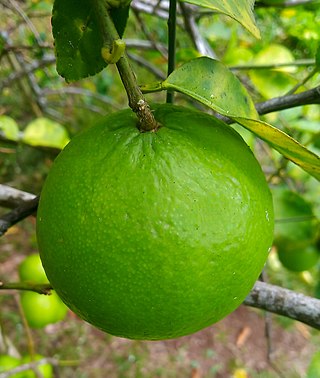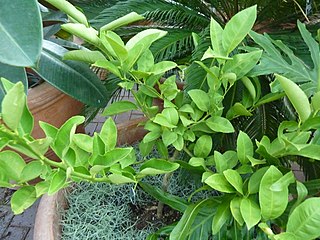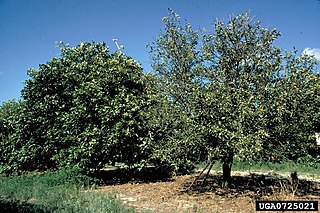
Kumquats, or cumquats in Australian English, are a group of small, angiosperm, fruit-bearing trees in the family Rutaceae. Their taxonomy is disputed. They were previously classified as forming the now-historical genus Fortunella or placed within Citrus, sensu lato. Different classifications have alternatively assigned them to anywhere from a single species, C. japonica, to numerous species representing each cultivar. Recent genomic analysis would define three pure species, Citrus hindsii, C. margarita and C. crassifolia, with C. x japonica being a hybrid of the last two.

Citrus is a genus of flowering trees and shrubs in the rue family, Rutaceae. Plants in the genus produce citrus fruits, including important crops such as oranges, lemons, grapefruits, pomelos, and limes. The genus Citrus is native to South Asia, East Asia, Southeast Asia, Melanesia, and Australia. Various citrus species have been used and domesticated by indigenous cultures in these areas since ancient times. From there its cultivation spread into Micronesia and Polynesia by the Austronesian expansion ; and to the Middle East and the Mediterranean via the incense trade route, and onwards to Europe and the Americas.

A clementine is a tangor, a citrus fruit hybrid between a willowleaf mandarin orange and a sweet orange, named in honor of Clément Rodier, a French missionary who first discovered and propagated the cultivar in Algeria. The exterior is a deep orange colour with a smooth, glossy appearance. Clementines can be separated into 7 to 14 segments. Similar to tangerines, they tend to be easy to peel. They are typically juicy and sweet, with less acid than oranges. Their oils, like other citrus fruits, contain mostly limonene as well as myrcene, linalool, α-pinene and many complex aromatics.

The mandarin orange, also known as mandarin or mandarine, is a small citrus tree fruit. Treated as a distinct species of orange, it is usually eaten plain or in fruit salads. Tangerines are a group of orange-coloured citrus fruit consisting of hybrids of mandarin orange with some pomelo contribution.

Citrus unshiu is a semi-seedless and easy-peeling citrus species, also known as miyagawa mandarin,unshu mikan, cold hardy mandarin, satsuma mandarin, satsuma orange, naartjie, and tangerine. During the Edo period of Japan, kishu mikan was the most popular because there was a popular superstition that eating Citrus unshiu (Satsuma) without seeds made people more prone to infertility. Citrus unshiu became popular in Japan after modernization started in the Meiji period. It was introduced to the West from the Satsuma region of Japan in 1878.

The trifoliate orange, Citrus trifoliata, is a member of the family Rutaceae. Whether the trifoliate oranges should be considered to belong to their own genus, Poncirus, or be included in the genus Citrus is debated. The species is unusual among citrus for having deciduous, compound leaves and pubescent (downy) fruit.

The Key lime or acid lime is a citrus hybrid native to tropical Southeast Asia. It has a spherical fruit, 25–50 mm (1–2 in) in diameter. The Key lime is usually picked while it is still green, but it becomes yellow when ripe.

The Mother Orange Tree is the oldest living orange tree in Northern California. The California Historical Landmark is located at 400 Glen Drive in Oroville, California.

Ponkan ; Citrus poonensis; "Chinese Honey Orange") is a high-yield sweet Citrus cultivar with large fruits in the size of an orange. It is a citrus hybrid, though it was once thought to be a pure mandarin.

An orange is a fruit of various citrus species in the family Rutaceae ; it primarily refers to Citrus × sinensis, which is also called sweet orange, to distinguish it from the related Citrus × aurantium, referred to as bitter orange. The sweet orange reproduces asexually ; varieties of the sweet orange arise through mutations.
Citrus tristeza virus (CTV) is a viral species of the genus Closterovirus that causes the most economically damaging disease to its namesake plant genus, Citrus. The disease has led to the death of millions of Citrus trees all over the world and has rendered millions of others useless for production. Farmers in Brazil and other South American countries gave it the name "tristeza", meaning sadness in Portuguese and Spanish, referring to the devastation produced by the disease in the 1930s. The virus is transmitted most efficiently by the brown citrus aphid.

The ponderosa lemon is a citrus hybrid of a pomelo and a citron. It is not the same as the 'Yuma Ponderosa' lemon-pomelo hybrid used as citrus rootstock.

The lemon is a species of small evergreen tree in the flowering plant family Rutaceae, native to Asia, primarily Northeast India (Assam), Northern Myanmar, or China.

Citrus taxonomy refers to the botanical classification of the species, varieties, cultivars, and graft hybrids within the genus Citrus and related genera, found in cultivation and in the wild.

Citrus limettioides, Palestinian sweet lime or Indian sweet lime or common sweet lime, alternatively considered a cultivar of Citrus × limon, C. × limon 'Indian Lime', is a low-acid lime used in Palestine for food, juice and rootstock. It is a member of the sweet limes. Like the Meyer lemon, it is the result of a cross between the citron and a mandarin/pomelo hybrid distinct from sweet and sour oranges.

Rough lemon is the fruit and the tree of a citrus hybrid. Like the rangpur, it is a cross between mandarin orange and citron.
Citrus rootstock are plants used as rootstock for citrus plants. A rootstock plant must be compatible for scion grafting, and resistant to common threats, such as drought, frost, and common citrus diseases.
Citrumelo is also called Swingle citrumelo trifoliate hybrid, because it is cold hardy and is a hybrid between a 'Duncan' grapefruit and a trifoliate orange, developed by Walter Tennyson Swingle.

Citrus blight is a type of blight that occurs in tropical and semi-tropical regions. Specializing in infecting citrus trees, the blight is found in North America, the Caribbean, South America, South Africa and Australia. The blight injures plants by forming blockages in xylem and phloem, inhibiting resource distribution and resulting in plant die-back and smaller fruit yields. As of 2020 there is no cure for the blight, and neither the causal agent nor spreading mechanism is known.

Volkamer lemon, often misspelled Volckamer lemon, is known as 沃 尔卡默柠檬 in Chinese, citron de Volkamer in French, limone Volkameriano in Italian, and chanh Volkamer in Vietnamese. It is a Citrus hybrid cultivated for its edible fruit. The specific epithet (volkameriana) honors German botanist Johann Christoph Volkamer.

















